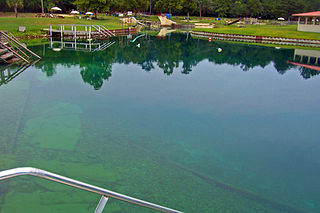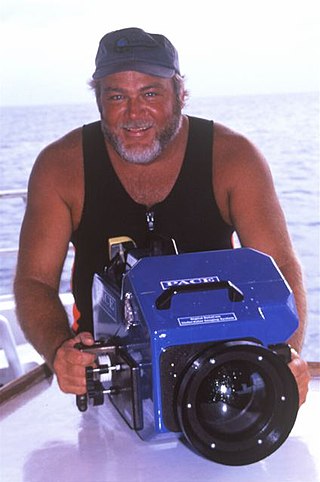Dive
In August 2015 Garman tried to set a record for a recreational scuba dive of 1,200 feet (370 m). [6] His wife and son were present at the dive site. The dive took place off the Saint Croix coast. Garman had arranged for a 1,300 feet (400 m) weighted line to be anchored in place as part of the dive. Garman was supported by dive operator the Scuba Tec dive team, of St. Croix Ultimate Bluewater Adventures, in the attempt. [7] He had a total support team of 28 people, including his oldest son, Kip Garman.
He began the dive at 6am as scheduled. [8] Initial descent to 200 metres (660 ft) with members of his support team went as planned. From there, he was to get to the bottom, solo, and return to an air station at a depth of 350 feet (110 m) within an estimated 38 minutes. From there he would make a slow ascent. However, he did not reach the rendezvous point. [1]

Technical diving is scuba diving that exceeds the agency-specified limits of recreational diving for non-professional purposes. Technical diving may expose the diver to hazards beyond those normally associated with recreational diving, and to a greater risk of serious injury or death. The risk may be reduced by appropriate skills, knowledge and experience, and by using suitable equipment and procedures. The skills may be developed through appropriate specialised training and experience. The equipment often involves breathing gases other than air or standard nitrox mixtures, and multiple gas sources.

Deep diving is underwater diving to a depth beyond the norm accepted by the associated community. In some cases this is a prescribed limit established by an authority, while in others it is associated with a level of certification or training, and it may vary depending on whether the diving is recreational, technical or commercial. Nitrogen narcosis becomes a hazard below 30 metres (98 ft) and hypoxic breathing gas is required below 60 metres (200 ft) to lessen the risk of oxygen toxicity.

Wreck diving is recreational diving where the wreckage of ships, aircraft and other artificial structures are explored. Although most wreck dive sites are at shipwrecks, there is an increasing trend to scuttle retired ships to create artificial reef sites. Diving to crashed aircraft can also be considered wreck diving. The recreation of wreck diving makes no distinction as to how the vessel ended up on the bottom.
Sheck Exley was an American cave diver. He is widely regarded as one of the pioneers of cave diving, and he wrote two major books on the subject: Basic Cave Diving: A Blueprint for Survival and Caverns Measureless to Man. On February 6, 1974, Exley became the first chairman of the Cave Diving Section of the American National Speleological Society. During his career, he established many of the basic safety procedures used in cave and overhead diving today. Exley was also a pioneer of extreme deep scuba diving.
The National Association of Underwater Instructors is a non-profit association of scuba instructors. It primarily serves as a recreational dive certification and membership organization established to provide international diver standards and education programs. The agency was founded in 1960 by Albert Tillman and Neal Hess. NAUI is headquartered in the Tampa, Florida area with dive and member instructors, resorts, stores, service and training centers, located around the world.

Scuba diving is a mode of underwater diving whereby divers use breathing equipment that is completely independent of a surface air supply, and therefore has a limited but variable endurance. The name "scuba", an acronym for "Self-Contained Underwater Breathing Apparatus", was coined by Christian J. Lambertsen in a patent submitted in 1952. Scuba divers carry their own source of breathing gas, usually compressed air, affording them greater independence and movement than surface-supplied divers, and more time underwater than free divers. Although the use of compressed air is common, a gas blend with a higher oxygen content, known as enriched air or nitrox, has become popular due to the reduced nitrogen intake during long and/or repetitive dives. Also, breathing gas diluted with helium may be used to reduce the likelihood and effects of nitrogen narcosis during deeper dives.
Boesmansgat, also known in English as "Bushman's Hole", is a deep submerged freshwater cave in the Northern Cape province of South Africa, which has been dived to a depth of 282.6 metres (927 ft).

Underwater diving, as a human activity, is the practice of descending below the water's surface to interact with the environment. It is also often referred to as diving, an ambiguous term with several possible meanings, depending on context. Immersion in water and exposure to high ambient pressure have physiological effects that limit the depths and duration possible in ambient pressure diving. Humans are not physiologically and anatomically well-adapted to the environmental conditions of diving, and various equipment has been developed to extend the depth and duration of human dives, and allow different types of work to be done.

Vortex Spring is a commercially operated recreation, camping and dive park located near Ponce de Leon, Florida. It is the largest diving facility in the state of Florida.
Mark Ellyatt is a British technical diver and instructor. He teaches technical diving all over the world, including the UK, Egypt, Lebanon and Greece.
John Bennett was a British scuba diver who set a world record by becoming the first person to deep dive below a depth of 300 m (1,000 ft) on self-contained breathing apparatus on 6 November 2001. Bennett first broke the record in 1999 when he reached 200 m (660 ft) accompanied by Chuck Driver. In 2000 Bennett set a new record of 254 m (833 ft), before his final record-breaking dive to 308 m (1,010 ft) in 2001. Having founded Atlantis Dive in the Philippines in the late 1990s, Bennett and his world record breaking team, including Ron Loos, Mark Cox and Targa Mann went on to establish Tech Dive Academy in Port Douglas, Australia. In the early 2000s, Bennett and Loos made the first dives to the MV Princess of the Orient wreck site in Manila Bay. In 2001, he located the wreck of the Imperial Japanese Navy dreadnought Yamashiro through sound scans, but could not confirm it before his death. Confirmation was not made until 2017.
Nuno Gomes is a scuba diver who lives in New York City. Born in Lisbon, his family relocated to Pretoria when he was 14 years old. He held two world records in deep diving, the cave diving record from 1996 to 2019 and the sea water record from 2005 to 2014.
Pascal Bernabé is a French scuba diver who in 2005 laid claim to the world best for depth on a deep dive using self-contained breathing apparatus. Bernabé claimed to have reached a maximum depth of 330 metres (1,080 ft) using trimix on 5 June 2005 near Propriano, Corsica. This was actually deeper than the official deepest scuba dive recognized by Guinness World Records at the time. That mark, set by Nuno Gomes in Dahab, Egypt, was 318.25 metres (1,044.1 ft) of sea water. However, Bernabé's claimed deepest dive was not included in the Guinness Book of World Records due to insufficient evidence of such a dive ever being performed.
Deon Dreyer was a South African recreational scuba diver who died in Bushman's Hole in South Africa. Cave diver David Shaw died more than 10 years later while attempting to retrieve Dreyer's body.

Bret Clifton Gilliam is a pioneering technical diver. He is most famous as the founder of the certification agency Technical Diving International, and as the one time holder of the world record for deep diving on air. He is also one of diving's most popular writers. Gilliam is the author or coauthor of 72 books, over 1500 feature magazine articles, and over 100 magazine cover photos. In his diving career he has logged over 19,000 dives since 1959.

The Frederiksted Pier is the 1,526-foot, deep water, cruise ship pier located in Frederiksted, U.S. Virgin Islands. It is located at the west end of Saint Croix, U.S. Virgin Islands and accommodate two Eagle-class vessels, of a maximum of 142,000 gross tons each with drafts up to 29 feet and two mini-cruise vessels with drafts of 18 feet. Anchorage is also available in the outer harbor for larger ships. The platform of the pier is equipped with a fendering system that is designed for submarines.

The history of scuba diving is closely linked with the history of the equipment. By the turn of the twentieth century, two basic architectures for underwater breathing apparatus had been pioneered; open-circuit surface supplied equipment where the diver's exhaled gas is vented directly into the water, and closed-circuit breathing apparatus where the diver's carbon dioxide is filtered from the exhaled breathing gas, which is then recirculated, and more gas added to replenish the oxygen content. Closed circuit equipment was more easily adapted to scuba in the absence of reliable, portable, and economical high pressure gas storage vessels. By the mid-twentieth century, high pressure cylinders were available and two systems for scuba had emerged: open-circuit scuba where the diver's exhaled breath is vented directly into the water, and closed-circuit scuba where the carbon dioxide is removed from the diver's exhaled breath which has oxygen added and is recirculated. Oxygen rebreathers are severely depth limited due to oxygen toxicity risk, which increases with depth, and the available systems for mixed gas rebreathers were fairly bulky and designed for use with diving helmets. The first commercially practical scuba rebreather was designed and built by the diving engineer Henry Fleuss in 1878, while working for Siebe Gorman in London. His self contained breathing apparatus consisted of a rubber mask connected to a breathing bag, with an estimated 50–60% oxygen supplied from a copper tank and carbon dioxide scrubbed by passing it through a bundle of rope yarn soaked in a solution of caustic potash. During the 1930s and all through World War II, the British, Italians and Germans developed and extensively used oxygen rebreathers to equip the first frogmen. In the U.S. Major Christian J. Lambertsen invented a free-swimming oxygen rebreather. In 1952 he patented a modification of his apparatus, this time named SCUBA, an acronym for "self-contained underwater breathing apparatus," which became the generic English word for autonomous breathing equipment for diving, and later for the activity using the equipment. After World War II, military frogmen continued to use rebreathers since they do not make bubbles which would give away the presence of the divers. The high percentage of oxygen used by these early rebreather systems limited the depth at which they could be used due to the risk of convulsions caused by acute oxygen toxicity.

The following outline is provided as an overview of and topical guide to underwater diving:

Deepspot is a 45-metre (148 ft) deep swimming pool and scuba diving training center, located near Warsaw in Mszczonów, Poland. It held the record for being the deepest swimming pool in the world until June 2021, when the 60-metre (200 ft) Deep Dive Dubai was opened.








